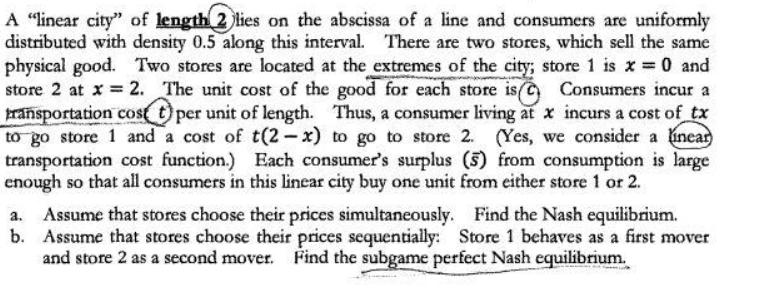A linear city of length 2 lies on the abscissa of a line and consumers are uniformly distributed with density 0.5 along this interval.

A "linear city" of length 2 lies on the abscissa of a line and consumers are uniformly distributed with density 0.5 along this interval. There are two stores, which sell the same physical good. Two stores are located at the extremes of the city; store 1 is x = 0 and store 2 at x = 2. The unit cost of the good for each store is Consumers incur a transportation cost per unit of length. Thus, a consumer living at x incurs a cost of_tx to go store 1 and a cost of t(2-x) to go to store 2. (Yes, we consider a linear transportation cost function.) Each consumer's surplus (5) from consumption is large enough so that all consumers in this linear city buy one unit from either store 1 or 2. a. Assume that stores choose their prices simultaneously. Find the Nash equilibrium. b. Assume that stores choose their prices sequentially: Store 1 behaves as a first mover and store 2 as a second mover. Find the subgame perfect Nash equilibrium.
Step by Step Solution
3.30 Rating (147 Votes )
There are 3 Steps involved in it
Step: 1
Step 11 Given a In this simultaneous price setting game the Nash equilibrium occurs w...
See step-by-step solutions with expert insights and AI powered tools for academic success
Step: 2

Step: 3

Ace Your Homework with AI
Get the answers you need in no time with our AI-driven, step-by-step assistance
Get Started


